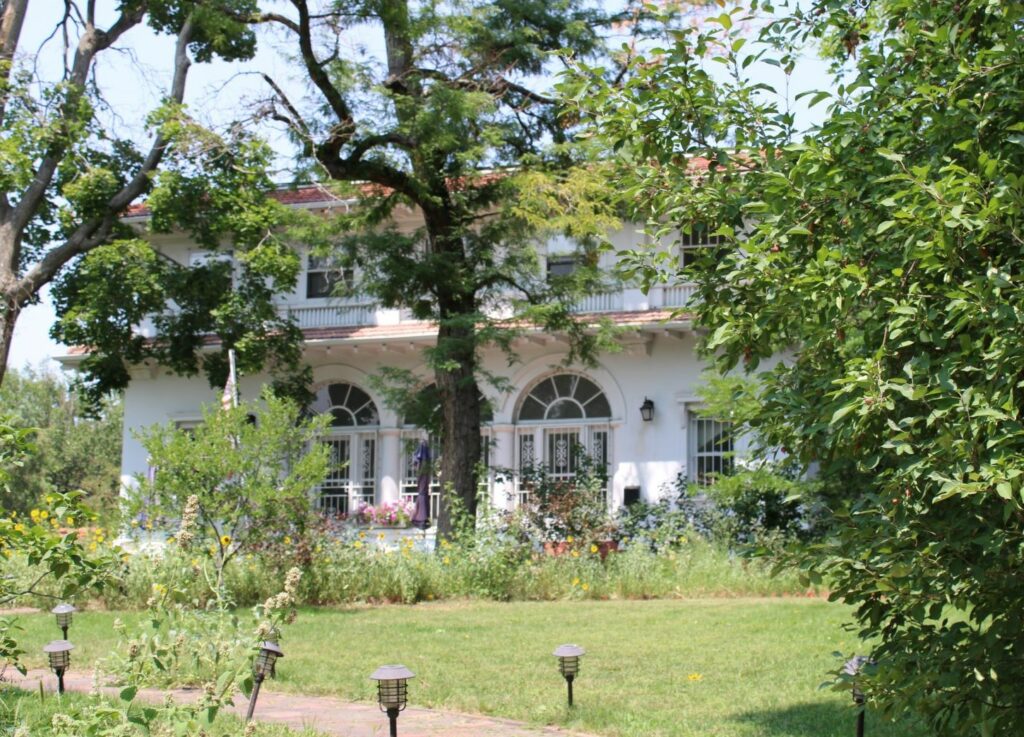
It sits on the wooded hill at the corner of 46th and Perry, a gentle reminder of the early days of the Berkeley-Regis neighborhoods and the prominent Denverites who established it. Now, the McDonough mansion has some new recognition of its historic past.
Historic Denver has selected the home — as well as three other Northside locations — as part of its “50 Actions, 50 Places” initiative to help celebrate the organization’s 50th anniversary. Earlier this year, Historic Denver asked community members to identify the next 50 places in the city that “I can’t imagine Denver without.” Submissions included places of historic importance in addition to many that local residents considered worthy of some type of preservation action or assistance, which might eventually include varied actions such as help with researching a place’s history, providing a plaque noting its significance, or identifying maintenance issues that should be addressed.
Michael Flowers, Historic Denver’s Director of Preservation Action, said the city received about 110 submissions, including a number for sites on the Northside. Historic Denver staff and members then narrowed the list to 50 based on a number of criteria. Besides the McDonough mansion, the final list includes, the Elitch’s Carousel House by 38th and Tennyson; Lakeside Amusement Park; and the house that formerly was the location of the groundbreaking Gender Identity Center at 3715 32nd Avenue, which served as a community center and safe space for transgender people from 1980-93.
Historic Berkeley-Regis submitted the McDonough mansion on the basis of numerous factors, underscoring its historic significance to the city. The dwelling was designed by Jules Jacques Benoit Benedict, one of the most prominent architects in Colorado history. Benedict’s work in the Denver area alone encompasses an array of iconic residential, commercial, and public space structures. This lengthy list includes, to name just a few, the Woodbury Branch of the Denver Public Library at Highland Park; the Cullen-Thompson Motor Co. building at 1000 Broadway (later home of the old Gart Bros. Sports Castle); Holy Ghost Church at 1900 California; the Herman Coors house in Golden; a wing of the Richthofen Castle in Montclair; Town Hall Arts Center in Littleton; and the structures for Sunken Gardens Park, the Chief Hosa Lodge and the Washington Park Boating Pavilion.
The McDonough mansion is Benedict’s earliest known completed house in Denver, built for another prominent local figure, John McDonough, under a permit issued Oct. 1, 1909. The building was completed early in 1910 with a value of $33,000, according to Historic Denver. Designed in Italian Renaissance Revival style architecture, the local Denver Republican described the home in 1912 as “one of the most beautiful residences in the city.” The original design included an entrance gate and a windmill, with the main house featuring a single story front porch with triple arches, topped with a balcony balustrade. The two one-story wings, extending from the main building at 45-degree angles, housed, on one side the kitchen, and, on the other, the home’s billiard room.
Such a home was fitting for McDonough, another member of the Denver elite whose real estate and investment firm led the development of a new suburb in what now is the Berkeley-Regis area. According to Ruth Eloise Wiberg’s history, “Rediscovering Northwest Denver,” McDonough moved into the new mansion from his previous home several blocks away in Harkness Heights, of which he also had led development as a new Denver suburb in the early 1900s.
McDonough died of a heart attack in August 1912 while driving home for lunch. His widow continued living in the home while she conducted his business for several years. Later residents included civic leader John Malm, an order of nuns, and other private residents. The current owner, Annette Tilleman-Dick, and her now-late husband Timber Dick bought the home in 1993, which itself started a new chapter in the history of their own storied Northside family.
“It is wonderful to realize many people are working behind the scenes in Denver to preserve the beauty and history of our community,” said Tilleman-Dick. “We are grateful for their efforts. Our family is thrilled our home, Theopolis, built for John McDonough and designed by the gifted Jules Jacques Benedict, was chosen, along with our cherished neighbor, Lakeside Amusement Park, to be among the 50 properties under consideration. As the personality of our streets and avenues are changing from month to month it is good to know some of the enchantment of our history will not be erased.”

Being born in Denver and grows no up there, in the early 70’s the historical significance changed.
The City of Denver lost many of the original buildings which included the First national Bank and many others.
This pleases me to see some progress to save these important Homes, businesses and Churches.
Thank You. CM